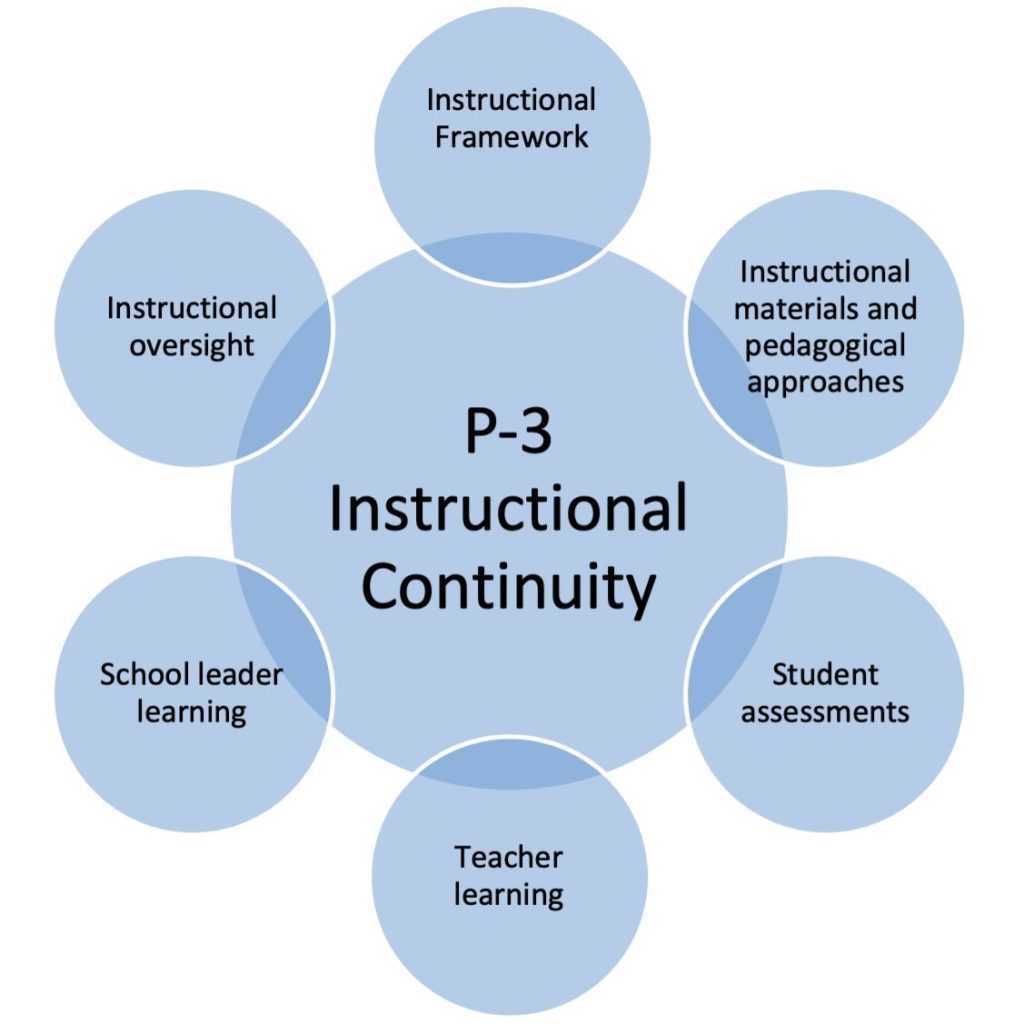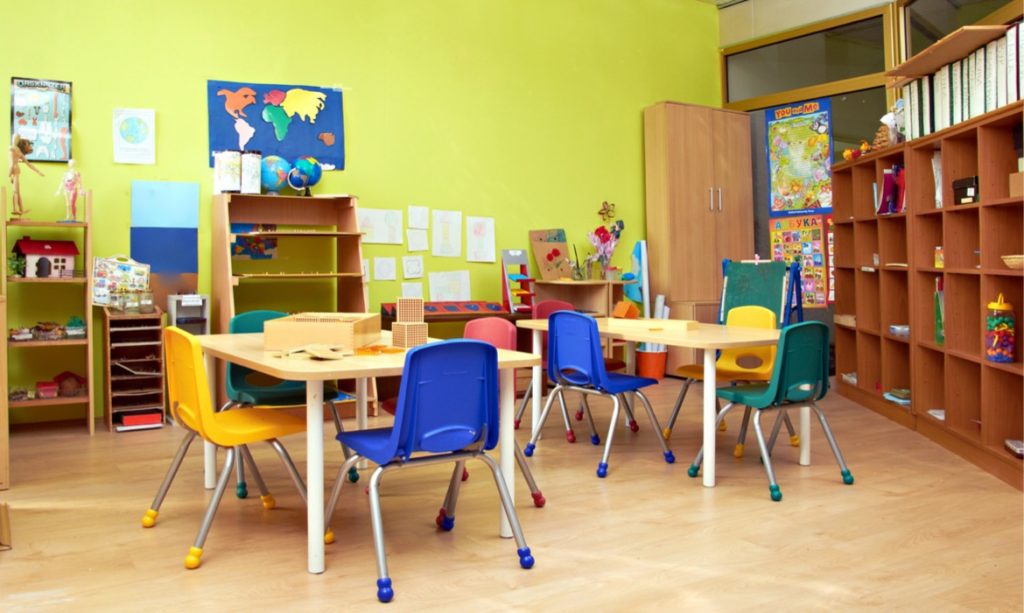Math learning in preschool is often disconnected from math learning in the early elementary grades. This disconnect can lead to students experiencing uneven instructional practices, which can compromise their learning. The goal of the DREME Preschool Through Elementary School Coherence (COHERE) project is to identify policies and practices that are associated with high quality, continuous math education from preschool through the early primary grades. Learn more about the COHERE project.
Preschool attendance is now the norm, and it is increasingly built into K-12 school systems. In many respects, as kindergarten has become the new first grade, preschool is becoming the new kindergarten. In this article, we draw on our four-year study of school district efforts to create more seamless pathways from preschool to elementary school. We offer a framework based on this and others’ research for considering strategies to ensure the long-term benefits of investment in preschool and to improve student learning in the early grades.
There are good reasons for the expansion of preschool. High-quality preschool can help K-12 districts and schools be more effective overall and reduce the achievement gap, which is typically substantial before children enter kindergarten (Reardon, 2013). Second, we know from neuroscience that there is substantial growth in brain functioning during the first five years. This growth, which is significantly affected by children’s experiences, creates the foundation for later learning (National Scientific Council on the Developing Child, 2007). Third, there is ample evidence that high-quality preschool experiences have long-term positive effects on students’ success in school (Yoshikawa et al., 2013).
Preschool ecology is complex and fragmented. Increasingly, however, preschool is part of the district system, overseen by district staff and under the elementary school principal’s leadership. District and school-level administrators throughout the U.S. are trying to figure out how to incorporate preschool productively and seamlessly into a system that until recently started with kindergarten.
There is no clear roadmap for how to incorporate preschool into district and elementary schools in terms of organization, staffing, curriculum, assessment, and so on. Much is written encouraging districts to embrace preschool and create continuity* between preschool and the early elementary grades (Kauerz, 2006; Kauerz, Ballard, Soli, & Hagerman, 2021). But there is little research on how best to optimize the benefits of preschool as children progress through the elementary grades. *We use the word “continuity” to refer to connections across grade levels. We use “alignment” to refer to connections across policies (e.g., professional development, curriculum, and teacher evaluation).
Ultimately what matters is providing children with a continuous educational experience in which each grade builds on what was learned in the previous grade, maximizing and sustaining the gains made in preschool to achieve better developmental and learning outcomes overall. To achieve this, skills taught in each grade must help children move toward the next step in achieving academic standards. Instruction is targeted just beyond students’ skill levels using similar pedagogical approaches adjusted to be developmentally appropriate. Children are given opportunities to broaden and deepen the skills they learned in the previous grade by applying them in novel and diverse contexts. This is what we mean by instructional continuity.
Note that continuity in instruction can be achieved by implementing similar but ineffective instructional strategies throughout the grades. Thus, while seeking greater continuity in instruction, attention needs to be given to the quality and effectiveness of the instruction as well as how continuous it is across grades.
While the interactions between teachers and students within the classroom are what matter most, these are affected by myriad school and district policies and practices. Researchers have identified five elements that district leaders need to consider in their efforts to support effective instruction (Hopkins & Spillane, 2015; Hopkins & Woulfin, 2015). Our own research revealed that these same five components, plus an additional one that is specifically relevant to preschool (school leader learning), are critical to an aligned and continuous system that maximizes children’s learning and development.
These elements serve as a framework, depicted below, for reviewing practices and policies designed to achieve effectiveness and continuity. The lines connecting the elements denote the need for each element to be aligned with the other elements. While all these elements are essential, the specific strategies used in each to achieve continuity are likely to vary, depending on state policies, the size of the district, resources, students served, and many other factors. Therefore, although there is no manual for this work, the framework can guide conversations that are informed by the local context. Moreover, policies and practices interact to form a package. It is the whole package—the way various policies and practices support and reinforce each other—that matters. To be effective, it is necessary to look across policies and their connections to each other. Next, we explain each of the elements.
Elements of a System to Support Instructional Continuity Across Grades

The first element is instructional framework. Instructional frameworks provide a vision for specific subject areas and guidance on what to teach and how to teach. Some districts rely on state standards and mandates; others develop their own or elaborate on the state standards. To guide how teachers teach, one district we studied created instructional practice guides aligned with the Common Core Standards. Another created what they called the Math Teaching Toolkit, which was also about pedagogical approaches.
Typically, school districts’ instructional frameworks apply only to K-12 but not to preschool. Extending the framework applied in the early elementary grades to preschool can improve instructional continuity. Many practices that are appropriate for older children need to be adapted for young children, so take care to ensure developmental appropriateness. In some cases, frameworks that apply to preschool might be extended upward into the elementary grades. For example, self-regulation and social emotional development are typically central to preschool standards, but often overlooked entirely in the elementary grades. This disconnect occurs despite evidence that many children in the early elementary grades could benefit, both academically and socially, from greater attention to these dimensions of their development.
Instructional materials and pedagogical approaches are the second element. Continuity in instructional materials is difficult to achieve because few commercially available curricula cover both preschool and elementary school. Even if different curricula are used, however, they can be selected with a close eye toward their connections.
The curriculum provides guidance on the scope and sequence of skills. But how teachers implement the curriculum is at least as, if not more, important than the curriculum used. Instructional continuity requires a great deal of attention to the quality and consistency of pedagogical practices. Consistency in practice does not mean that the exact same strategies are used in every grade. The same pedagogical approach may look quite different depending on students’ ages and skills. For example, while third graders might be able to verbally explain how they solved a math problem, younger children may need to explain by manipulating objects or drawing a picture. The general principle of having children explain their reasoning can apply across grades, but adjusted to be age-appropriate. Being consistent with such a practice contributes to children’s learning because they don’t have to learn a whole new way of doing math when they move from grade to grade.
Student assessments are the third element of the framework. Many states do not require student assessments until third grade, but most states and districts use some form of assessments before then. If districts use a preschool assessment, it is not necessarily continuous with what is used in kindergarten, and few commercially available assessments span preschool and the early elementary grades.
Clearly, assessment instruments need to align with classroom instruction. Ensuring continuity of formative assessments across grades has the added value of providing useful information on whether children are on track to meet expectations in the next grade. Accordingly, they can be used to guide instructional decisions for the class and individual children. Continuity of assessments that track student progress between preschool and the early grades can also help districts determine whether the policies they have implemented are working effectively to support children’s progress and reduce the achievement gap. Given the typically wide span of skill levels in any grade, there should be some assessment overlap from the previous and subsequent grades. Ideally, assessment instruments are continuous, showing where children are on their learning trajectory regardless of their grade.
The fourth element of the framework is the system for teacher learning. This includes professional learning programs and coaching, as well as opportunities for teachers to meet and learn with one another in professional learning communities. In general, preschool teachers are offered fewer professional learning opportunities than are teachers of older children, despite their critical role in creating the foundation for children’s future learning. Including teachers from preschool and the early elementary grades in the same professional learning or having the same coach work with both groups can contribute substantially to instructional continuity.
Teachers also benefit from meeting with each other across the grades. Preschool teachers need to understand the educational program for which they are preparing children. Research based on a national representative sample revealed that kindergarten teachers often repeat instruction on skills that children had already mastered before entering kindergarten (Engel, Claessens, & Finch, 2013). Further, the more that teachers repeated content, the less that children learned in kindergarten (Engel et al., 2016). A better understanding of the preschool instructional program would help kindergarten teachers expand on skills that children already mastered. Furthermore, the span of skill levels that teachers of different grades have in their classrooms is highly overlapping. Preschool teachers may have some children in their classroom who are sufficiently advanced in their learning to begin working on kindergarten-level skills. For preschool teachers to support children’s continued development, they need to be familiar with the kindergarten standards and curriculum. Likewise, kindergarten teachers are likely to have some children in their classroom who have not mastered all the skills expected of preschoolers. They need to know how to provide all children with developmentally appropriate instruction.
For logistical reasons, it is often difficult for preschool teachers to meet with elementary grade teachers, and there are other common obstacles, such as differences in training, credentials, and pay that make collegial connections difficult (Koppich & Stipek, 2020; Stein & Coburn, 2021). Although not easy, there is considerable value to making efforts to bridge this divide.
The fifth element of the instructional guidance infrastructure is school leader learning. Sometimes school leaders are not well enough informed about what teachers are doing. Without that, it’s difficult for leaders to support and reinforce teachers for their efforts. Indeed, what teachers are learning in professional learning programs or from coaches is occasionally contradicted by school leaders, creating teacher frustration and confusion rather than instructional coherence.
School leaders need to learn how to support the preschool classrooms at their school site. In our study of two districts’ efforts to create better alignment between preschool and K-3, elementary school principals in both districts formally supervised the preschools on their campuses. In one district, principals were given the option of some training in early childhood education, which few availed themselves of, in part because their direct supervisor was not reinforcing the superintendent’s emphasis on P-3 coherence. In the other district, all the principals attended an institute on early childhood education developed by the district, followed up by classroom visits that district leaders also attended. In the former district, principal interviews revealed low confidence in their ability to provide meaningful supervision and support, and some resentment of having to take on the additional work of preschools; they engaged with preschool mainly around operational issues (e.g., compliance paperwork, IEPs). In the district where school leaders received consistent messages about the value of preschool and training and support in early childhood education, principals were more likely to value preschool, express a strong sense of responsibility for its success, and engage instructionally with the preschool classrooms.
The final element of the instructional guidance infrastructure is instructional oversight. Instructional oversight is the way that districts monitor instruction and learning in classrooms. Instructional oversight includes practices such as instructional walkthroughs, routines for analyzing data on student performance, and teacher and school leader evaluations. Combining preschool with the elementary grades in these processes provides information on the connections between the two. When district leaders do walkthroughs, for example, they can examine instructional continuity across grades. Preschool can also be included in examinations of data on student learning, teacher turnover, or other indicators of the effectiveness of district, school, and classroom practices.
No amount of information or data or analysis at the district level is useful if it is not conveyed to teachers along with support to help them understand the implications for their practice. Learning that their teaching is not consistent with the district’s instructional guidance may not affect their teaching without assistance in making the appropriate changes. Learning that a large proportion of their children are far behind grade level in February can demoralize rather than motivate teachers who are not given opportunities to develop the tools they need to be more effective. Instructional oversight is important, but only as a tool to identify teacher learning needs.
Efforts to create P-3 instructional continuity also raise questions about the organization of district leaders. If the director of early learning is not part of the leadership team that meets regularly, that person is not likely to be well informed of issues, policies, and practices that might be relevant to preschool, and does not have a regular opportunity to inform K-8 or K-12 leaders of issues related to preschool. Making the person who is responsible for preschool an integral member of the leadership team also sends a clear message that preschool is a central part of a continuous educational program.
Conclusions
The framework we offer does not provide a manual for improving continuity between preschool and the elementary grades. Instead, it suggests issues that school and district administrators who want to invest in preschool and ensure its long-term benefits need to address in order to meet their goals. The actual strategies that districts and schools use will vary substantially. By monitoring the effects of district policies on teaching and learning, policies can be fine-tuned to have maximum benefit.
Integrating preschool into elementary school should not involve simply pushing down the elementary curriculum and teaching approaches into preschool, as many advocates of early childhood education fear. It is an opportunity to provide a developmentally appropriate educational program for children throughout the early grades, lay a strong foundation for learning, and sustain the social emotional and academic gains children make in preschool.
Engel, M., Claessens, A., & Finch, M. (2013). Teaching students what they already know. The (mis)alignment between mathematics instructional content and student knowledge in kindergarten. Educational Evaluation and Policy Analysis, 35(2), 157–178.
Engel, M., Claessens, A., Watts, T., & Farkas, G. (2016). Mathematics content coverage and student learning in kindergarten. Educational Researcher, 45(5) 293–300.
Hopkins, M. & Spillane, J. P. (2015). Reconceptualizing relations between instructional guidance infrastructure (IGI) and teachers’ beliefs about mathematics instruction: Regulative, normative and cultural-cognitive considerations. Journal of Educational Change, 16, 421-450.
Kauerz, K. (2006). Ladders of learning: Fighting fade-out by advancing PK-3 alignment. New America Foundation Early Education Initiative, Issue Brief No. 3.
Kauerz, K., Ballard, R., Soli, M., & Hagerman, S. (2021). Leading learning communities: A principal’s guide to early learning and the early grades (Pre-K–3rd Grade). Alexandria, VA: National Association of Elementary School Principals.
Koppich, J., & Stipek, D. (2020). PreK–3 alignment: Challenges and Opportunities. California Policy Analysis for California Education: Stanford University.
National Scientific Council on the Developing Child (2007). The Timing and Quality of Early Experiences Combine to Shape Brain Architecture: Working Paper No. 5. Retrieved from www.developingchild.harvard.edu.
Reardon, S. (2013). The widening income achievement gap. Educational Leadership, 70 (8), 10-16.
Stein, M. A. & Coburn, C. E. (2021). PreK – 3 initiatives: Challenges of fostering alignment and continuity in two school districts. Educational Policy.
Yoshikawa, H., Weiland, C. Brooks-Gunn, J., Burchinal, M., Espinosa, L. Gormley, W., Ludwig, J., Magnuson, K., Phillips, D., & Zaslow, M. (2013). Investing in Our Future: The Evidence Base on Preschool Education. Ann Arbor, MI: Society for Research in Child Development.



